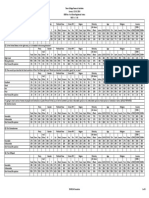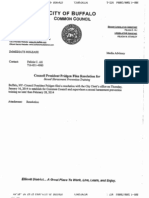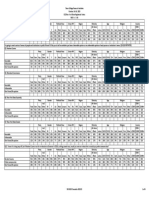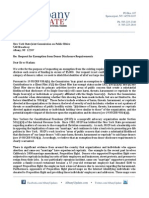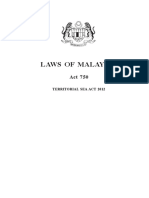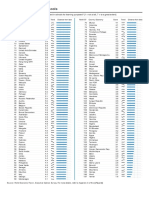Professional Documents
Culture Documents
The Size of The Senate - A Reply To Michael Carvin - 8 Jan 2012
Uploaded by
embenjamin2001Original Description:
Original Title
Copyright
Available Formats
Share this document
Did you find this document useful?
Is this content inappropriate?
Report this DocumentCopyright:
Available Formats
The Size of The Senate - A Reply To Michael Carvin - 8 Jan 2012
Uploaded by
embenjamin2001Copyright:
Available Formats
The Size of the New York State Senate: a Reply to Michael Carvin Todd A.
Breitbart January 8, 2012 On Friday, January 6, the NYS Legislative Task Force on Demographic Research and Reapportionment (LATFOR) posted on the FAQ page of its web site a memorandum titled Senate Size, dated January 5, 2012, from Michael Carvin, outside counsel to the NYS Senate Majority. Mr. Carvins memo presents the Republicans new interpretation of the NYS constitutional rule for determining the number of State Senate districts. Mr. Carvin falsely claims that an increase from 62 to 63 districts is the necessary and straightforward application of his previous interpretation, given in a memo, also titled Senate Size, dated March 7, 2002. Most of Mr. Carvins new memo is devoted to arguing that I erred in testifying at a LATFOR hearing that the interpretation he offered in 2002, when applied to the 2010 census data, would again produce 62 districts. Essentially, Mr. Carvin faults me for applying, consistently, what he called in 2002 "the best method for apportioning the New York Senate," the "methodology [that] is most consistent with the intent underlying the New York Constitution." As explained below, the constitutional rule requires that present-day counties be compared with the counties and Senate districts as they stood when the rule was adopted in 1894. For this purpose certain pairs of counties must be treated as though each pair were a single county. There are two different procedures, both reasonable, that might be followed for combining the counties. One procedure was applied to every pair of counties in 1972, 1982 and 1992. The other was applied to every pair of counties in 2002. The Senate Republicans and their counsel Mr. Carvin have now decided that they cannot achieve their partisan designs by following one constitutional rule consistently. They apply one procedure to one pair of counties, and a different procedure to another pair, in order to arrive at the exact number of districts that will suit their partisan purposes. There is no justification for this inconsistent and self-contradictory practice, and they have offered none. Instead, they attempt to obscure what they are doing. Historical and Legal Background For those coming into this conversation in the middle, some background will be helpful.
I directed the staff work on redistricting for the Minority (Democratic) Leaders of the New York State Senate from 1980 through my retirement at the end of 2005. I have offered advice to the redistricting staff of the Democratic Senate Conference during the current redistricting process, and exchanged information with them, but I do not now work for or represent the Minority Leader. I consulted with the Committee on Election Law of the Bar Association of the City of New York during the preparation of their 2007 report on reform of the redistricting process, and was the principal drafter of the text, but I do not, and never did, represent or speak for the Committee or the Association. (I am not a lawyer.) The opinions I express are solely my own.
The Size of the NYS Senate: a Reply to Michael Carvin Todd Breitbart 1/8/12 p. 2
The number of Senate districts is determined by a rule, dating from 1894, in Article III, 4, of the NY State Constitution. The rule applies to counties that contain more than 6% of the total state population. Whenever the population of such a county rises to a larger proportion of the statewide total than in 1894 counting by increments of 1/50th (2%) of the state total, after dropping the remainders then a district is added to the total of 50 districts that were created in 1894. The counties that have grown enough to matter are Bronx, Nassau, Queens, Richmond, Suffolk, and Westchester. A countys decline in population, relative to the rest of the state, has no effect, and a county with less than 6% of the state population does not figure in the formula. The rule is somewhat ambiguous because the NYS Court of Appeals has ruled that the population comparison must be based on the counties as they were in 1894.1 Nassau County was created out of Queens County in 1899, so Queens and Nassau are treated as a unit.2 According to one interpretation of the rule, Westchester County must be considered as a unit with the part of the Bronx east of the Bronx River, since that area was part of Westchester in 1894, but other interpretations combine the whole of Bronx County with New York County, or with both New York and Westchester Counties.3 (Bronx County did not exist until 1914.) The Court has also ruled that Richmond and Suffolk Counties must be treated as a unit, since those two counties were combined as a single Senate district in 1894.4 There have been two different methods of combining the counties for this comparison. One method was used in the reapportionment law of 1972, upheld that year by the Court of Appeals in Schneider v. Rockefeller,5 and used again without question in 1982 and 1992. The Senate Republicans drew all of these reapportionment plans. That formula produced 60 districts in 1972, and 61 districts in 1982 and 1992. The increase of one district resulted from changes in population distribution, not from a change in the formula. If the same formula had been applied in 2002, there would again have been 61 districts. The Republican Senate Majority decided, however, that their political calculations would be best served by creating 62 districts in 2002.6 The Senate Majoritys outside counsel, Mr. Carvin, then produced his March 7, 2002 memo justifying the new
1 2 3
Schneider v. Rockefeller, 31 N.Y.2d 420, 432 (1972) Id. at 432-433.
Id. at 433-434. See also Carvin, Senate Size, March 7, 2002, section titled 1. Westchester, New York and Bronx Counties.
4 5 6
Id. at 435. Id. at 432-433.
An internal Senate Majority memorandum, dated July 20, 2001, and divulged during the document discovery phase of Rodriguez v. Pataki (2004), states: We have had numerous discussions regarding the possibility of the Senate increasing in size to 63. While the ultimate decision will be made with political numbers for proposed districts at each size in hand, I believe that the decision basically comes down to the raw census numbers. There is no discussion of what the NYS Constitution might require. Memorandum titled Size of the Senate (filename: Not63), July 20, 2001, at 1, Rodriguez v. Pataki SDNY 02 Civ. 618. The memo can be found at the following locations: http://blog.timesunion.com/capitol/archives/81427/senate-spokesmen-duel-over-prospect-of-63rd-member/ http://www.nydailynews.com/blogs/dailypolitics/2011/09/hammond-the-smoking-gun-on-redistricting
The Size of the NYS Senate: a Reply to Michael Carvin Todd Breitbart 1/8/12 p. 3
formula. From that date until last week, the 2002 memo, which remained on the LATFOR web site, was the only guidance provided to the public about the correct method for determining the number of Senate districts. Then late in the afternoon of Friday, January 6, 2012, Mr. Carvins new memo was added. Determining the Proper Number of Senate Districts The current disagreement concerns the procedure for aggregating the populations of the present-day counties, for comparison with the counties and districts of 1894. This is not a dispute over the proper method to use. The question is whether one method either method is to be used consistently. Mr. Carvin's new method is to follow one procedure for combining the populations of Queens and Nassau, which constituted Senate District 2 in 1894, and a different procedure for Richmond and Suffolk, which then constituted Senate District 1. In the following discussion I will refer, for the sake of convenience, to Procedure A and Procedure B (my terms). The term ratio of apportionment means 1/50th (2%) of the total state population. The number of full ratios in a county is determined by dividing the countys population by the ratio of apportionment, then dropping the remainder. So a county with 2.01% of the state population, and an county with 3.99%, would both have one full ratio. Procedure A: Combine the populations of the two counties, and then round down to the number of 'full ratios' contained in the combined population. Procedure B: Round down the population of each county separately to the number of full ratios in each county, and then add the full ratios (after rounding, not before). This is the procedure that Mr. Carvin described in his March 7, 2002 memo as part of "the best method for apportioning the New York Senate," the "methodology [that] is most consistent with the intent underlying the New York Constitution."7 In 1972 (as upheld in Schneider v. Rockefeller), and again in 1982 and 1992, Procedure A was used by Republican Senate majorities in each year. In order to get to 62 districts in 2002, but not 63, Mr. Carvin argued for the following. 1) The part of the Bronx east of the Bronx River should be combined with Westchester, not with New York County as in the three prior decades. This
7
Mr. Carvins March 7, 2002 memo is now available as an attachment to his January 5, 2012 memo: http://latfor.state.ny.us/faqs/docs/2012senatesize.pdf The memos are also available by a link from the LATFOR FAQ page: http://latfor.state.ny.us/faqs/ In the 2002 memo, the phrases quoted above appear in the first paragraph, and the method he advocated for combining counties is presented in the second and third paragraphs from the end, under the heading 2. Nassau and Queens Counties.
The Size of the NYS Senate: a Reply to Michael Carvin Todd Breitbart 1/8/12 p. 4
brought Westchester into play, by bringing the combined population above the 6% threshold, and thereby added two districts beyond what the previous interpretation of the Bronx/Westchester/New York history would have produced. 2) County-combination Procedure B, as described above, should be used instead of Procedure A. This second change produced a reduction of one district when applied to the Queens/Nassau combination, but no difference elsewhere. The net effect of the two changes was an increase of one district, from 61 to 62, as explained in Mr. Carvins March 7, 2002 memo. Mr. Carvins New Mix-and-Match Calculation Mr. Carvin now argues that county-combination Procedure A should be used for Richmond and Suffolk, while county-combination Procedure B should be used again for Queens and Nassau. He seeks to hide the inconsistency in the table that follows his new memo (2010 Senate Size Calculation) by showing separately the populations of the counties (or parts of Bronx County) that figure in every other part of the calculation, but stating the combined population of Richmond and Suffolk, from the outset, as a single number. Of course, no such number is to be found in any census data tabulation except Mr. Carvin's. If he had displayed the entire calculation for every combination, the inconsistency would have been glaringly obvious. The label Mr. Carvin uses in his table is "District 1 (Richmond/Suffolk)," after which he shows the combined current population of the counties and the number of full ratios derived from that combined population. His justification for listing Richmond/Suffolk as a unit, with the combined 2010 population, not the sum of the separately computed full ratios is that he is simply listing the present day population of what in 1894 was Senate District 1. But the first three sentences of the NYS Constitution, Article III, 3, in the original 1894 text,8 are as follows: 3. [Senate districts.]-The State shall be divided into fifty districts to be called senate districts, each of which shall choose one senator. The districts shall be numbered from one to fifty, inclusive. District number one (1) shall consist of the counties of Suffolk and Richmond. District number two (2) shall consist of the county of Queens. The area that in 1894 was the county of Queens now comprises the counties of Queens and Nassau. So why does Mr. Carvin list the present-day Queens and Nassau
8
The 1894 text of the Constitution is available at: http://www.nycourts.gov/history/constitutions/1894_constitution.htm
The Size of the NYS Senate: a Reply to Michael Carvin Todd Breitbart 1/8/12 p. 5
Counties separately, showing the current population of each? Why does he not simply show: "District 2 (Queens/Nassau)," with the combined population, since the present-day Queens and Nassau counties constituted District 2 in 1894? The obvious answer is that, in order to arrive at the exact number of districts that serves the Senate Republicans' partisan calculation, he must, when dealing with the District 2 of 1894, employ what he called in 2002 the "methodology [that] is most consistent with the intent underlying the New York Constitution." But to arrive at the desired result, he must also employ a different methodology when dealing with the District 1 of 1894. If county-combination Procedure B were applied consistently, the result would be 62 districts, as shown in the technical appendix to the written testimony I submitted to LATFOR on September 22, 2011. If Procedure A were used consistently, the result would be 64 districts, since the combined populations of Queens and Nassau would equal 9.21 full ratios, which according to Procedure A would then be rounded down to 9, not 8 - producing an addition of 8 full ratios, not 7, over Queens County's one Senate district of 1894. (The 64-district possibility was not addressed in anyones testimony, since no one has ever advocated that the treatment of the Bronx adopted in 2002, which Mr. Carvin proposes to employ again this year, be combined with county-combination Procedure A. The constitutional interpretation adopted by the Senate Republicans in 1972, 1982, and 1992, taken as a whole, and the different interpretation they adopted in 2002, would each produce 62 districts if applied consistently to the 2010 census data.) Mr. Carvin offers no justification for the inconsistency, except to argue that Procedure A was always used previously for Richmond and Suffolk. But the same was true in 1972, 1982, and 1992 for Queens and Nassau as well. For 2002 the case of Richmond and Suffolk is undetermined, since both methods would have produced the same result for Richmond/Suffolk on the basis of the 2000 census. The last paragraph of Part IV of the Court of Appeals decision in Schneider v. Rockefeller, 31 N.Y.2d 420, 434 (1972), reads in full: Finally, there is no dispute as to the increase of two senators attributable to the grouping of Richmond and Suffolk Counties, which under the 1894 Constitution constituted one Senate district. The apparent reason is that, in this instance, under either method -- aggregating of population or aggregating of full ratios -- the same result is indicated -- an increase of two senators. The Court gives no indication that the case of Suffolk/Richmond was to be distinguished from that of Queens/Nassau, and it would have made no difference. The method of aggregating populations, then rounding down afterward, was used for all county combinations in 1982 and 1992 (and by the Federal District Courts Special Master in 1982). In 2002, both methods of aggregation would again have produced the same result for Richmond/Suffolk, just as noted by the Court of Appeals in reference to the 1972 redistricting. In 2002, both methods produced an increase of three districts over the one Richmond/Suffolk district of 1894.
The Size of the NYS Senate: a Reply to Michael Carvin Todd Breitbart 1/8/12 p. 6
Mr. Carvin's March 7, 2002 memorandum does not mention the Richmond/Suffolk combination. It was unnecessary to do so, since both methods would have produced the same result. If he meant to distinguish the Richmond/Suffolk case, and to arrive at the same result, but by a different constitutional reading, he did not reveal that until January 5, 2012. If the two cases were indeed distinguished in 2002, Mr. Carvin has held that secret in his heart of hearts for ten painful years. The Richmond/Suffolk combination did not figure in the size-of-the-Senate formula until 1972. (According to the 1960 census counts, the Richmond/Suffolk combination did not yet reach the threshold of three full ratios, by either method of reckoning.9) So when Mr. Carvin, in his January 5, 2012 memo, says that the proper method "is to combine Richmond and Suffolk's populations as has been done in every redistricting," he is speaking only of the redistrictings of 1972 through 2002. In 1972, 1982, and 1992, however, this method was also used for Queens and Nassau, and in 2002 both procedures would have produced the same result for Richmond and Suffolk. Neither Mr. Carvin nor anyone else said anything in 2002 about adopting, for the first time, differing methods of calculation for Richmond/Suffolk and Queens/Nassau. It seems that Mr. Carvin now reads his own March 7, 2002 memo as containing several substantial paragraphs that are not to be seen there, and that no one else could have guessed at. One might have supposed that Mr. Carvin was being consistent in 2002. He now tells us otherwise. The invisible paragraphs presumably explained that the method for aggregating county populations or full ratios was to depart from the 19721992 precedents for Queens/Nassau, but not for Richmond/Suffolk. Presumably the invisible paragraphs also explained the basis for this distinction, but Mr. Carvin has not yet revealed his reasoning. When I made the statement cited in Mr. Carvin's latest memo, that the legal theory in his March 7, 2002 memo - as distinguished from the circumstances in which it was produced - was reasonable, I was unaware that the theory had hidden, unexplained provisions that do not actually appear in the 2002 memo. 10
The total state population in 1960 was 16,782,304, yielding a 'full ratio' of 335,646. Richmond had a population of 221,991, and Suffolk had 666,784. The total of 888,775 would have been 2.65 ratios - only 2 full ratios - not enough to matter. Taken separately, Richmond had zero full ratios (its population was less than one full ratio), and Suffolk had one (1.99, rounded down), for a total of one full ratio for the combination The only difference between the two pairs of counties is that Queens/Nassau involves comparison with a single 1894 county (Queens) as well as a single 1894 district (District 2), while Richmond/Suffolk involves comparison with a single 1894 district (District 1) where the counties remain unchanged. But this provides no basis at all for using inconsistent procedures to combine present-day counties in making the comparison. If Queens and Nassau had been separate counties in 1894, but a single district (1894 District 2), the growth of their populations would still bring them into the Senate-size computation, just as population growth has brought Richmond and Suffolk (1894 District 1) into the computation. As noted above, the only legal precedent that addresses these two county combinations attaches no significance to this difference (Schneider v. Rockefeller, 31 N.Y.2d 420, 434 [1972]). Mr. Carvin does not mention it in his 2002 memo, and he offers no reason for it in his 2012 memo. Indeed, as shown above, his latest memo tries to obscure the fact that he is treating the two county combinations differently, not to offer a reason for doing so.
10
9
The Size of the NYS Senate: a Reply to Michael Carvin Todd Breitbart 1/8/12 p. 7
The Senate Majoritys Tell-tale Timing The timing of the new Carvin memo is telling. If the number of districts were to be determined on the basis of Mr. Carvin's reasoning, the matter could have been settled definitively in March, when the block-level census data became available. If Mr. Carvin had meant - for reasons not yet explained - to distinguish the Queens/Nassau and Richmond/Suffolk cases in 2002, but just forgot to mention it in his 2002 memo, he need not have waited until January 5, 2012 to make good his omission. Sen. Nozzolio could have sought Mr. Carvin's guidance on the constitutional issue after any of the many occasions when this matter was addressed during the hearings and meetings of LATFOR. The public have again been misled, and encouraged as in 2001-02 to propose plans for a different number of districts than the Senate Majority intended to create. No one relying on Mr. Carvin's March 7, 2002 memo, as the LATFOR FAQ page encouraged them to do, could have guessed that his interpretation would yield any number but 62 districts when applied to the 2010 census data. To have known about the distinction between the method for combining Queens and Nassau and the method for combining Richmond and Suffolk, they had to be privy to the hidden provisions of Mr. Carvins constitutional theory the invisible paragraphs of his 2002 memo. It is clear that Senators Skelos and Nozzolio waited until they had decided the number of districts that would serve their partisan purposes - exactly as Sen. Skelos did as Co-Chair of LATFOR in 2001-02 - and that, having again made the decision for reasons having nothing to do with constitutional rules, they again left it to Mr. Carvin to provide a constitutional rationale. In 2002, Mr. Carvin was able to provide a legal theory that was reasonable, if considered apart from the circumstances in which he produced it, and if applied consistently. This year he has not been able to discover a reasonable theory that yields the desired result.
You might also like
- The Sympathizer: A Novel (Pulitzer Prize for Fiction)From EverandThe Sympathizer: A Novel (Pulitzer Prize for Fiction)Rating: 4.5 out of 5 stars4.5/5 (119)
- Devil in the Grove: Thurgood Marshall, the Groveland Boys, and the Dawn of a New AmericaFrom EverandDevil in the Grove: Thurgood Marshall, the Groveland Boys, and the Dawn of a New AmericaRating: 4.5 out of 5 stars4.5/5 (266)
- A Heartbreaking Work Of Staggering Genius: A Memoir Based on a True StoryFrom EverandA Heartbreaking Work Of Staggering Genius: A Memoir Based on a True StoryRating: 3.5 out of 5 stars3.5/5 (231)
- Grit: The Power of Passion and PerseveranceFrom EverandGrit: The Power of Passion and PerseveranceRating: 4 out of 5 stars4/5 (588)
- The Little Book of Hygge: Danish Secrets to Happy LivingFrom EverandThe Little Book of Hygge: Danish Secrets to Happy LivingRating: 3.5 out of 5 stars3.5/5 (399)
- Never Split the Difference: Negotiating As If Your Life Depended On ItFrom EverandNever Split the Difference: Negotiating As If Your Life Depended On ItRating: 4.5 out of 5 stars4.5/5 (838)
- The Subtle Art of Not Giving a F*ck: A Counterintuitive Approach to Living a Good LifeFrom EverandThe Subtle Art of Not Giving a F*ck: A Counterintuitive Approach to Living a Good LifeRating: 4 out of 5 stars4/5 (5794)
- The Emperor of All Maladies: A Biography of CancerFrom EverandThe Emperor of All Maladies: A Biography of CancerRating: 4.5 out of 5 stars4.5/5 (271)
- The World Is Flat 3.0: A Brief History of the Twenty-first CenturyFrom EverandThe World Is Flat 3.0: A Brief History of the Twenty-first CenturyRating: 3.5 out of 5 stars3.5/5 (2219)
- Shoe Dog: A Memoir by the Creator of NikeFrom EverandShoe Dog: A Memoir by the Creator of NikeRating: 4.5 out of 5 stars4.5/5 (537)
- Team of Rivals: The Political Genius of Abraham LincolnFrom EverandTeam of Rivals: The Political Genius of Abraham LincolnRating: 4.5 out of 5 stars4.5/5 (234)
- The Hard Thing About Hard Things: Building a Business When There Are No Easy AnswersFrom EverandThe Hard Thing About Hard Things: Building a Business When There Are No Easy AnswersRating: 4.5 out of 5 stars4.5/5 (344)
- The Gifts of Imperfection: Let Go of Who You Think You're Supposed to Be and Embrace Who You AreFrom EverandThe Gifts of Imperfection: Let Go of Who You Think You're Supposed to Be and Embrace Who You AreRating: 4 out of 5 stars4/5 (1090)
- Her Body and Other Parties: StoriesFrom EverandHer Body and Other Parties: StoriesRating: 4 out of 5 stars4/5 (821)
- Con Law ChecklistDocument15 pagesCon Law Checklistzoti_lejdi91% (11)
- Elon Musk: Tesla, SpaceX, and the Quest for a Fantastic FutureFrom EverandElon Musk: Tesla, SpaceX, and the Quest for a Fantastic FutureRating: 4.5 out of 5 stars4.5/5 (474)
- Hidden Figures: The American Dream and the Untold Story of the Black Women Mathematicians Who Helped Win the Space RaceFrom EverandHidden Figures: The American Dream and the Untold Story of the Black Women Mathematicians Who Helped Win the Space RaceRating: 4 out of 5 stars4/5 (895)
- The Unwinding: An Inner History of the New AmericaFrom EverandThe Unwinding: An Inner History of the New AmericaRating: 4 out of 5 stars4/5 (45)
- The Yellow House: A Memoir (2019 National Book Award Winner)From EverandThe Yellow House: A Memoir (2019 National Book Award Winner)Rating: 4 out of 5 stars4/5 (98)
- On Fire: The (Burning) Case for a Green New DealFrom EverandOn Fire: The (Burning) Case for a Green New DealRating: 4 out of 5 stars4/5 (73)
- Dynamics 20of 20structures Chopra 3d 20ed Solutionmanual 130626104732 Phpapp02Document535 pagesDynamics 20of 20structures Chopra 3d 20ed Solutionmanual 130626104732 Phpapp02Jhe GerardNo ratings yet
- Despiritualization A Central Theme in Western Thought by Oba T ShakaDocument10 pagesDespiritualization A Central Theme in Western Thought by Oba T ShakaAtyeb Ba Atum Re100% (2)
- Old NCERT World History Ch8Document18 pagesOld NCERT World History Ch8Mudita Malhotra75% (8)
- Briones vs. Court of AppealsDocument1 pageBriones vs. Court of AppealsKenneth Ray TagleNo ratings yet
- Reflections of Social Theory in IndiaDocument25 pagesReflections of Social Theory in IndiaAnjana RaghavanNo ratings yet
- Barangay Assembly MinutesDocument5 pagesBarangay Assembly MinutesBarangay Cagangohan83% (6)
- Semiotics, Structuralism, and Postmodern TheoryDocument19 pagesSemiotics, Structuralism, and Postmodern TheoryLee ThachNo ratings yet
- NY1/NYT/Siena Poll of NYC Mayor Bill de Blasio's First 100 Days.Document5 pagesNY1/NYT/Siena Poll of NYC Mayor Bill de Blasio's First 100 Days.embenjamin2001No ratings yet
- Good Government Groups Oppose Public Campaign Finance Pilot in 2014-15 Budget Deal.Document2 pagesGood Government Groups Oppose Public Campaign Finance Pilot in 2014-15 Budget Deal.embenjamin2001No ratings yet
- Hudson Valley For Cuomo Reception Invite.Document2 pagesHudson Valley For Cuomo Reception Invite.embenjamin2001No ratings yet
- Charlie King Attacks Rep. Chris Collins...Document3 pagesCharlie King Attacks Rep. Chris Collins...embenjamin2001No ratings yet
- NYPIRG's Annual "Getting A Bit O'the Green" List of Fundraisers in Albany During The Legislative Session.Document4 pagesNYPIRG's Annual "Getting A Bit O'the Green" List of Fundraisers in Albany During The Legislative Session.embenjamin2001No ratings yet
- Broom Co Lincoln Day Dinner Announcement For Friday, Feb. 28.Document1 pageBroom Co Lincoln Day Dinner Announcement For Friday, Feb. 28.embenjamin2001No ratings yet
- IDC's Universal Pre-K Report.Document8 pagesIDC's Universal Pre-K Report.embenjamin2001No ratings yet
- Jan. 20 Siena Poll.Document9 pagesJan. 20 Siena Poll.embenjamin2001No ratings yet
- Statement From 23 Charter School Organizations On Need For "Unity" in Albany.Document2 pagesStatement From 23 Charter School Organizations On Need For "Unity" in Albany.embenjamin2001No ratings yet
- Letter To Goodell PDFDocument2 pagesLetter To Goodell PDFTim RichardsonNo ratings yet
- Trump Poll, December 2013Document12 pagesTrump Poll, December 2013embenjamin2001No ratings yet
- Niagara Co Legislature Unanimously Passes Resolution Opposing Cuomo's "College-For-Criminals" PlanDocument2 pagesNiagara Co Legislature Unanimously Passes Resolution Opposing Cuomo's "College-For-Criminals" Planembenjamin2001No ratings yet
- Siena Poll, Sept. 30Document8 pagesSiena Poll, Sept. 30embenjamin2001No ratings yet
- Scanned From A Xerox Multifunction Device-1Document2 pagesScanned From A Xerox Multifunction Device-1embenjamin2001No ratings yet
- A Fourth Woman Makes Allegations Against Assemblyman Dennis Gabryszak.Document5 pagesA Fourth Woman Makes Allegations Against Assemblyman Dennis Gabryszak.embenjamin2001No ratings yet
- Unshackle Upstate: "Money For Nothing" White Paper.Document8 pagesUnshackle Upstate: "Money For Nothing" White Paper.embenjamin2001No ratings yet
- Legality of SAFE Act Upheld, Does Not Violate The 2nd Amendment.Document76 pagesLegality of SAFE Act Upheld, Does Not Violate The 2nd Amendment.embenjamin2001No ratings yet
- IOGA Pro-Facking Postcard Features ObamaDocument2 pagesIOGA Pro-Facking Postcard Features Obamaembenjamin2001No ratings yet
- SNY1013 Crosstabs 102113Document6 pagesSNY1013 Crosstabs 102113Nick ReismanNo ratings yet
- NYC Mayor Poll BPDocument5 pagesNYC Mayor Poll BPCeleste KatzNo ratings yet
- NYC1013 Crosstabs PDFDocument6 pagesNYC1013 Crosstabs PDFCeleste KatzNo ratings yet
- SNY0613 CrosstabsDocument9 pagesSNY0613 CrosstabsJimmy VielkindNo ratings yet
- SNY1013 Crosstabs 102213Document2 pagesSNY1013 Crosstabs 102213tulocalpoliticsNo ratings yet
- O'Mara Letter 06 May 2013Document2 pagesO'Mara Letter 06 May 2013embenjamin2001No ratings yet
- Eliot Spitzer's Conflict of Interest Board FilingDocument23 pagesEliot Spitzer's Conflict of Interest Board Filingembenjamin2001No ratings yet
- Nycf Jcope ExemptionDocument2 pagesNycf Jcope ExemptionJimmy VielkindNo ratings yet
- Group Letter Re May 7 HearingDocument2 pagesGroup Letter Re May 7 Hearingrobertharding22No ratings yet
- NYC0713 CrosstabsDocument9 pagesNYC0713 CrosstabsCeleste KatzNo ratings yet
- SNY May 2013 Poll Release - FINAL-1Document8 pagesSNY May 2013 Poll Release - FINAL-1embenjamin2001No ratings yet
- Crosstabs From Siena Poll, April 22Document8 pagesCrosstabs From Siena Poll, April 22embenjamin2001No ratings yet
- History ProjectDocument6 pagesHistory ProjectFarhana Rahman 1530095030No ratings yet
- February 2021 Licensure Examination For Social Workers ResultsDocument10 pagesFebruary 2021 Licensure Examination For Social Workers ResultsRapplerNo ratings yet
- PreambleDocument7 pagesPreambleAlfaz FirdousNo ratings yet
- The Rebirth of EuropeDocument352 pagesThe Rebirth of EuropeAbdur RahmanNo ratings yet
- FWPR in INDIADocument19 pagesFWPR in INDIADaVid Silence KawlniNo ratings yet
- The Refutation That Ash'aries & Maturidis Deny Allah's Attributes and Sidi Abu Iyad FromDocument4 pagesThe Refutation That Ash'aries & Maturidis Deny Allah's Attributes and Sidi Abu Iyad FromAbdullahFaheemAlMalikiNo ratings yet
- Nigeria Constitution Alteration ActDocument10 pagesNigeria Constitution Alteration ActAbū Bakr Aṣ-ṢiddīqNo ratings yet
- Saul Alinsky Rules For RadicalsDocument1 pageSaul Alinsky Rules For RadicalsBrightIdeasNottsNo ratings yet
- APPROVED CHAPTER 1.docx 1Document43 pagesAPPROVED CHAPTER 1.docx 1HASANUDDIN ASMAD. HASSIMANNo ratings yet
- POL 431 Nov 2020Document198 pagesPOL 431 Nov 2020Ebuka sixtusNo ratings yet
- Laws of Malaysia: Territorial SeaDocument8 pagesLaws of Malaysia: Territorial SeaSweetCharity77No ratings yet
- Roger Bannister For UNISON General Secretary LeafletDocument2 pagesRoger Bannister For UNISON General Secretary LeafletGreg MaughanNo ratings yet
- Eligibility List For A Type (288 SQM Plot) : Booklet Id/ Appl. Id Name Father Name Quota Subquota Prop Type Age MobileDocument1 pageEligibility List For A Type (288 SQM Plot) : Booklet Id/ Appl. Id Name Father Name Quota Subquota Prop Type Age MobilesunuprvunlNo ratings yet
- Wef Gci 2017 2018 Scorecard Eosq084Document1 pageWef Gci 2017 2018 Scorecard Eosq084Indra D. KristionoNo ratings yet
- Crown Office ContactDocument3 pagesCrown Office ContactDrew McNaughtonNo ratings yet
- The EU and The So-Called Democratic Deficit Demids Tjulkins LBDocument3 pagesThe EU and The So-Called Democratic Deficit Demids Tjulkins LBDemids TjuļkinsNo ratings yet
- Role of NBA in Promoting Rule of LawDocument7 pagesRole of NBA in Promoting Rule of LawNasiru0290% (1)
- Fox News Poll, August 14Document26 pagesFox News Poll, August 14Fox News0% (1)
- KidulthoodDocument1 pageKidulthoodNatashaAfia-AnoNo ratings yet
- Makan - Adalah's Journal For Land, Planning and Justice - Vol. 1 - The Right To The CityDocument100 pagesMakan - Adalah's Journal For Land, Planning and Justice - Vol. 1 - The Right To The CityAdalah - The Legal Center for Arab Minority Rights in IsraelNo ratings yet
- UMW Sunday Services 2015Document23 pagesUMW Sunday Services 2015klein emperadoNo ratings yet
- Doraemon As Japan's Soft DiplomacyDocument3 pagesDoraemon As Japan's Soft DiplomacyIrvin- NurinaNo ratings yet
























































